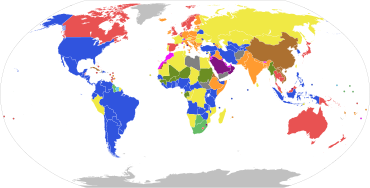
Back Апрезиденттә ҳәынҭқарра Abkhazian Präsidialrepublik ALS نظام رئاسي Arabic نظام رئاسى ARZ Sistema presidencialista AST Prezident respublikası Azerbaijani Präsidentiells Regiarungssysdem BAR Прэзідэнцкая рэспубліка Byelorussian Прэзыдэнцкая рэспубліка BE-X-OLD Президентска република Bulgarian

Parliamentary systems: Head of government is elected or nominated by and accountable to the legislature
Presidential system: Head of government (president) is popularly elected and independent of the legislature
Hybrid systems:
Other systems:
Note: this chart represents the de jure systems of government, not the de facto degree of democracy.
| Part of the Politics series |
| Politics |
|---|
|
|
A presidential, strong-president, or single-executive system is a form of government in which a head of government (usually titled "president") heads an executive branch that derives its authority and legitimacy from a source that is separate from the legislative branch. The system was popularized by its inclusion in the Constitution of the United States.[1]
This head of government is in most cases also the head of state. In a presidential system, the head of government is directly or indirectly elected by a group of citizens and is not responsible to the legislature, and the legislature cannot dismiss the president except in extraordinary cases. A presidential system contrasts with a parliamentary system, where the head of government (usually called a prime minister) derives their power from the confidence of an elected legislature, which can dismiss the prime minister with a simple majority.
Not all presidential systems use the title of president. Likewise, the title is sometimes used by other systems. It originated from a time when such a person personally presided over the governing body, as with the President of the Continental Congress in the early United States, prior to the executive function being split into a separate branch of government. It may also be used by presidents in semi-presidential systems. Heads of state of parliamentary republics, largely ceremonial in most cases, are called presidents. Dictators or leaders of one-party states, whether popularly elected or not, are also often called presidents.
The presidential system is the dominant form of government in Latin America and is also popular in Sub-Saharan Africa. By contrast, there are very few presidential republics in Europe (with Cyprus and Turkey being the only examples). In Asia, the system is used by South Korea, the Philippines, and Indonesia.
- ^ "Varieties of public representation". Political Representation. Cambridge University Press. 2010. ISBN 978-0521128650.